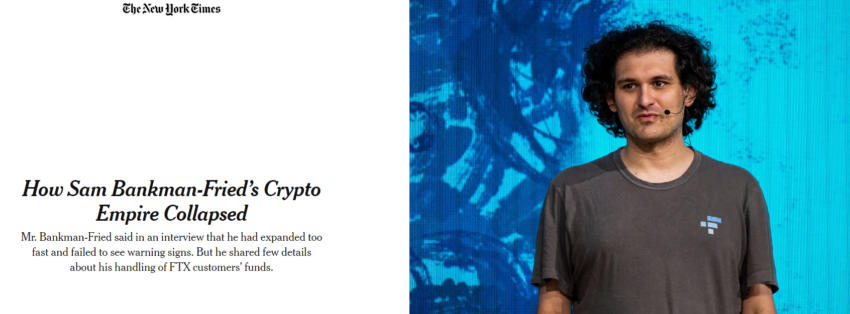Crypto misinformation has taken root in current reporting. In recent times Mainstream Media houses have come under pressure for false reports on the crypto ecosystem. You might be forgiven to think these houses took note and planned a different reporting strategy. They did not. Once more, the crypto community has voiced their displeasure with fabricated data.
The New York Times cringy BTC mining report
The latest report on Bitcoin mining by The New York Times, titled “The Real-World Costs of the Digital Race for Bitcoin,” has angered many BTC advocates. A number of Bitcoin advocates criticized certain aspects of the report on Twitter, labeling them “cherry-picked data.”
The New York Times article describes Bitcoin mining as a “voracious appetite” and asserts that Bitcoin mining consumes as much energy as all the homes in New York City. The crypto community swiftly criticized the New York Times for the article.
New York Times publishes an appallingly cynical article about Bitcoin mining.
— Bitcoin Archive (@BTC_Archive) April 10, 2023
They imply that the ability of Bitcoin miners to switch off when demand is high, like in Texas during a snowstorm, is market manipulation.
Last gasps of a dying publication.https://t.co/Xf4e831o5Y pic.twitter.com/HOw3pmSpCe
Bitcoin mining has always been a contentious issue, frequently fueled by erroneous information spread by mainstream publications. Every other year, mainstream publications have disseminated articles claiming that Bitcoin mining would be environmentally disastrous.
There are ongoing efforts to replace Bitcoin’s mining consensus with proof-of-stake. However, Bitcoin advocates continue to combat misinformation and set records straight. The majority of Bitcoin was mined in China until June 2021. Afterward, it expelled Bitcoin operations, at least temporarily, citing their energy consumption as one of the reasons. Soon after that, the United States became the global leader in the industry.
Crypto community members go after NYT
At first glance, a Riot Platforms executive criticized The New York Times for its recent publication of incorrect information about Bitcoin mining. Shortly thereafter, other members of the industry joined him in his criticism of the media outlet.
NYTimes finally ran their #Bitcoin mining piece! 🧵 pic.twitter.com/QbwrU1GF1C
— Pierre Rochard (@BitcoinPierre) April 10, 2023
Pierre Rochard, the vice president of Riot Platforms, a mining company, requests that the publication make its methodology and simulation open source so that others can observe how the data was obtained.
According to him, the methodology of the research was the primary concern. According to him, there was “a great deal of fictitious fractional-reserve carbon accounting” and “cooking the books to fabricate emissions.” The New York Times claimed to have conducted a market simulation.
Lots of fictitious fractional-reserve carbon accounting. Cooking the books to fabricate emissions. pic.twitter.com/mxufWFr3RZ
— Pierre Rochard (@BitcoinPierre) April 10, 2023
The New York Times identified 34 large-scale mining operations using both public and confidential records and commissioned studies to establish “the most comprehensive estimates to date on the largest operations’ power consumption and the ripple effects of their voracious demand.”
They "conducted a market-based simulation"
— Pierre Rochard (@BitcoinPierre) April 10, 2023
I hope they open source this so we can verify. pic.twitter.com/Gtpy5Djh9i
The article made several references to Riot Platforms. The New York Times reported that its mining operation in Rockdale, Texas consumed approximately the same amount of electricity as 300,000 nearby homes, “making it the most energy-intensive Bitcoin mining operation in the United States.”
In addition, Daniel Batten, a Bitcoin environmental, social, and governance (ESG) analyst, highlighted what he deemed to be two major instances of cherry-picking data, as well as the mining industry’s neglect of the increased use of renewable energy.
Here's 2 quick reasons why we should have zero-trust in the NYTimes article on Bitcoin.
— Daniel Batten (@DSBatten) April 10, 2023
First have a look at the table they compiled on the top 6 miners (the full table is much longer)
I have the actual data from these miners (and the others in their table) compiled over an 8… pic.twitter.com/hDzRLBeIOT
Batten stated that the NYT article grossly exaggerates the actual fossil fuel consumption of BTC miners by an average of 81.7%. He added that the report was “supported by overwhelmingly incomplete datasets.”
Dennis Porter, chief executive officer of the Satoshi Act Fund, remarked that the New York Times article made an error in its initial reporting by identifying the wrong Texas city as the location of a Bitcoin mining facility. The error was later rectified by the publication.
Wow. The NYT couldn’t even take the time to fact check the town that #Bitcoin mining is taking place in.
— Dennis Porter (@Dennis_Porter_) April 10, 2023
It’s to Rockdale, Texas. Not Rockland.
These are not serious people. pic.twitter.com/72ed3uIiga
New York Times Criticized for SBF Piece
This is not the first time that the New York Times has angered the crypto community. The publication’s “breathless love letter” to Sam Bankman-Fried drew widespread criticism. The argument at the time was that the New York Times had published a glowing profile of the disgraced former FTX CEO.

Several prominent figures in the industry, including Brian Armstrong, Jesse Powell, Zooko Wilcox, and Edward Snowden, were among the critics of that article. If this story on mining gains traction within the crypto community, the New York Times may have to face another salvo from the crypto community.
Recently, media outlets have been criticized for their coverage of the crypto industry. The crypto market and Binance Coin in particular took a hit last week after rumors circulated that Interpol had issued an arrest warrant for Binance CEO Changpeng Zhao.
They first write "news" about potential rumors,
— CZ 🔶 Binance (@cz_binance) April 4, 2023
then they write "news" about the rumors being false.
People choose to lose credibility over some clicks. 🤷♂️
The resulting FUD sparked some community concern. Zhao and others vehemently refuted such rumors and urged individuals to be wary of their information sources. Being a crypto flag bearer, CZ has been in a DeFi FUD war for some time. However, he has managed to handle it to the best of his abilities to date. Many in the FinTech sector have laid it bear “journalism is dead.”
I needed 5 min of search to understand:
— doncrypto (@DonCryptoDraper) April 4, 2023
– the CZ interpol pic is fake
– the FUD against Binance is engineered on purpose
– Cobie had nothing to do with it
They want your bitcoin don’t panic sell it to them until 1 million. https://t.co/YbNnb60GMw
 cryptopolitan.com
cryptopolitan.com
